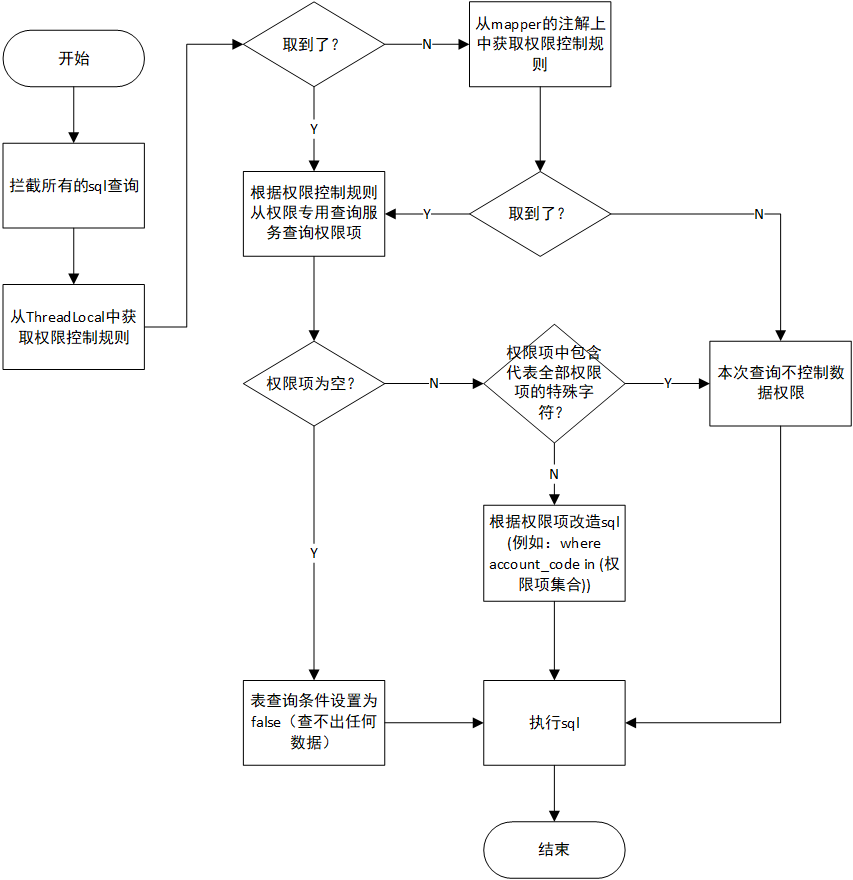

 使用mybatis切片实现数据权限控制
使用mybatis切片实现数据权限控制
电子说
描述
一、使用方式
数据权限控制需要对查询出的数据进行筛选,对业务入侵最少的方式就是利用mybatis或者数据库连接池的切片对已有业务的sql进行修改。切片逻辑完成后,仅需要在业务中加入少量标记代码,就可以实现对数据权限的控制。这种修改方式,对老业务的逻辑没有入侵或只有少量入侵,基本不影响老业务的逻辑和可读性;对新业务,业务开发人员无需过多关注权限问题,可以集中精力处理业务逻辑。
由于部门代码中使用的数据库连接池种类较多,不利于切片控制逻辑的快速完成,而sql拼接的部分基本只有mybatis和java字符串直接拼接两种方式,因此使用mybatis切片的方式来完成数据权限控制逻辑。在mybatis的mapper文件的接口上添加注解,注解中写明需要控制的权限种类、要控制的表名、列名即可控制接口的数据权限。

由于mybatis的mapper文件中的同一接口在多个地方被调用,有的需要控制数据权限,有的不需要,因此增加一种权限控制方式:通过ThreadLocal传递权限控制规则来控制当前sql执行时控制数据权限。

权限控制规则格式如下:
限权规则code1(表名1.字段名1,表名2.字段名2);限权规则code2(表名3.字段名3,表名4.字段名4)
例如:enterprise(channel.enterprise_code);account(table.column);channel(table3.id)
上下文传递工具类如下所示,使用回调的方式传递ThreadLocal可以防止使用者忘记清除上下文。
public class DataAuthContextUtil {
/**
* 不方便使用注解的地方,可以直接使用上下文设置数据规则
*/
private static ThreadLocal< String > useDataAuth = new ThreadLocal< >();
/**
* 有的sql只在部分情况下需要使用数据权限限制
* 上下文和注解中均可设置数据权限规则,都设置时,上下文中的优先
*
* @param supplier
*/
public static < T > T executeSqlWithDataAuthRule(String rule, Supplier< T > supplier) {
try {
useDataAuth.set(rule);
return supplier.get();
} finally {
useDataAuth.remove();
}
}
/**
* 获取数据权限标志
*
* @return
*/
public static String getUseDataAuthRule() {
return useDataAuth.get();
}
}
二、切片实现流程

三、其他技术细节
(1)在切面中获取原始sql
import lombok.extern.slf4j.Slf4j;
import org.apache.commons.collections4.CollectionUtils;
import org.apache.commons.lang3.StringUtils;
import org.apache.ibatis.cache.CacheKey;
import org.apache.ibatis.executor.Executor;
import org.apache.ibatis.mapping.BoundSql;
import org.apache.ibatis.mapping.MappedStatement;
import org.apache.ibatis.mapping.SqlSource;
import org.apache.ibatis.plugin.Interceptor;
import org.apache.ibatis.plugin.Intercepts;
import org.apache.ibatis.plugin.Invocation;
import org.apache.ibatis.plugin.Signature;
import org.apache.ibatis.reflection.DefaultReflectorFactory;
import org.apache.ibatis.reflection.MetaObject;
import org.apache.ibatis.reflection.factory.DefaultObjectFactory;
import org.apache.ibatis.reflection.wrapper.DefaultObjectWrapperFactory;
import org.apache.ibatis.session.ResultHandler;
import org.apache.ibatis.session.RowBounds;
import org.springframework.beans.factory.annotation.Autowired;
import org.springframework.stereotype.Component;
import reactor.util.function.Tuple2;
import java.lang.reflect.Method;
import java.util.HashMap;
import java.util.List;
import java.util.Map;
import java.util.Set;
@Component
@Intercepts({
// @Signature(type = Executor.class, method = "update", args = {MappedStatement.class, Object.class}),
@Signature(type = Executor.class, method = "query", args = {MappedStatement.class, Object.class, RowBounds.class, ResultHandler.class}),
@Signature(type = Executor.class, method = "query", args = {MappedStatement.class, Object.class, RowBounds.class, ResultHandler.class, CacheKey.class, BoundSql.class})
})
@Slf4j
public class DataAuthInterceptor implements Interceptor {
@Override
public Object intercept(Invocation invocation) throws Throwable {
try {
MappedStatement mappedStatement = (MappedStatement) invocation.getArgs()[0];
BoundSql boundSql = mappedStatement.getBoundSql(invocation.getArgs()[1]);
String sql = boundSql.getSql();
} catch (Exception e) {
log.error("数据权限添加出错,当前sql未加数据权限限制!", e);
throw e;
}
return invocation.proceed();
}
}
(2)将权限项加入原始sql中
使用druid附带的ast解析功能修改sql,代码如下
/**
* 权限限制写入sql
*
* @param sql
* @param tableAuthMap key:table value1:column value2:values权限项
* @return
*/
public static StringBuilder addAuthLimitToSql(String sql, Map< String, Tuple2< String, Set< String >> > tableAuthMap) {
List< SQLStatement > stmtList = SQLUtils.parseStatements(sql, "mysql");
StringBuilder authSql = new StringBuilder();
for (SQLStatement stmt : stmtList) {
stmt.accept(new MySqlASTVisitorAdapter() {
@Override
public boolean visit(MySqlSelectQueryBlock x) {
SQLTableSource from = x.getFrom();
Set< String > tableList = new HashSet< >();
getTableList(from, tableList);
for (String tableName : tableList) {
if (tableAuthMap.containsKey(tableName)) {
x.addCondition(tableName + "in (...略)");
}
}
return true;
}
});
authSql.append(stmt);
}
return authSql;
}
private static void getTableList(SQLTableSource from, Set< String > tableList) {
if (from instanceof SQLExprTableSource) {
SQLExprTableSource tableSource = (SQLExprTableSource) from;
String name = tableSource.getTableName().replace("`", "");
tableList.add(name);
String alias = tableSource.getAlias();
if (StringUtils.isNotBlank(alias)) {
tableList.add(alias.replace("`", ""));
}
} else if (from instanceof SQLJoinTableSource) {
SQLJoinTableSource joinTableSource = (SQLJoinTableSource) from;
getTableList(joinTableSource.getLeft(), tableList);
getTableList(joinTableSource.getRight(), tableList);
} else if (from instanceof SQLSubqueryTableSource) {
SQLSubqueryTableSource tableSource = (SQLSubqueryTableSource) from;
tableList.add(tableSource.getAlias().replace("`", ""));
} else if (from instanceof SQLLateralViewTableSource) {
log.warn("SQLLateralView不用处理");
} else if (from instanceof SQLUnionQueryTableSource) {
//union 不需要处理
log.warn("union不用处理");
} else if (from instanceof SQLUnnestTableSource) {
log.warn("Unnest不用处理");
} else if (from instanceof SQLValuesTableSource) {
log.warn("Values不用处理");
} else if (from instanceof SQLWithSubqueryClause) {
log.warn("子查询不用处理");
} else if (from instanceof SQLTableSourceImpl) {
log.warn("Impl不用处理");
}
}
}
(3)将修改过后的sql写回mybatis
MappedStatement ms = (MappedStatement) invocation.getArgs()[0];
BoundSql boundSql = ms.getBoundSql(invocation.getArgs()[1]);
// 组装 MappedStatement
MappedStatement.Builder builder = new MappedStatement.Builder(ms.getConfiguration(), ms.getId(), new MySqlSource(boundSql), ms.getSqlCommandType());
builder.resource(ms.getResource());
builder.fetchSize(ms.getFetchSize());
builder.statementType(ms.getStatementType());
builder.keyGenerator(ms.getKeyGenerator());
if (ms.getKeyProperties() != null && ms.getKeyProperties().length != 0) {
StringBuilder keyProperties = new StringBuilder();
for (String keyProperty : ms.getKeyProperties()) {
keyProperties.append(keyProperty).append(",");
}
keyProperties.delete(keyProperties.length() - 1, keyProperties.length());
builder.keyProperty(keyProperties.toString());
}
builder.timeout(ms.getTimeout());
builder.parameterMap(ms.getParameterMap());
builder.resultMaps(ms.getResultMaps());
builder.resultSetType(ms.getResultSetType());
builder.cache(ms.getCache());
builder.flushCacheRequired(ms.isFlushCacheRequired());
builder.useCache(ms.isUseCache());
MappedStatement newMappedStatement = builder.build();
MetaObject metaObject = MetaObject.forObject(newMappedStatement, new DefaultObjectFactory(), new DefaultObjectWrapperFactory(), new DefaultReflectorFactory());
metaObject.setValue("sqlSource.boundSql.sql", newSql);
invocation.getArgs()[0] = newMappedStatement;
参考文章: https://blog.csdn.net/e_anjing/article/details/79102693
审核编辑 黄宇
-
鸿蒙开发组件:DataAbility权限控制2024-06-21 1007
-
mybatis的dao能重载吗2023-12-03 1909
-
如何利用MyBatis Plus去实现数据权限控制呢?2023-08-23 1876
-
基于Mybatis拦截器实现数据范围权限2023-06-20 1982
-
SpringBoot+Mybatis如何实现流式查询?2023-06-12 1843
-
权限系统中的数据权限设计经验分享2022-10-11 2855
-
Fluent Mybatis、原生Mybatis和Mybatis Plus对比2022-09-15 1957
-
MyBatis的整合2019-10-28 723
-
数据库整合Mybatis框架2019-07-16 1349
-
基于SpringBoot mybatis方式的增删改查实现2019-06-18 2009
-
MyBatis的实现原理2018-02-24 6985
-
基于ThinkPHP的权限控制模块的设计与实现许宏云2017-03-17 1085
-
PLM系统中数据权限控制研究2011-03-07 1013
-
基于RBAC的限制约束在权限控制中的实现2010-01-15 778
全部0条评论

快来发表一下你的评论吧 !

